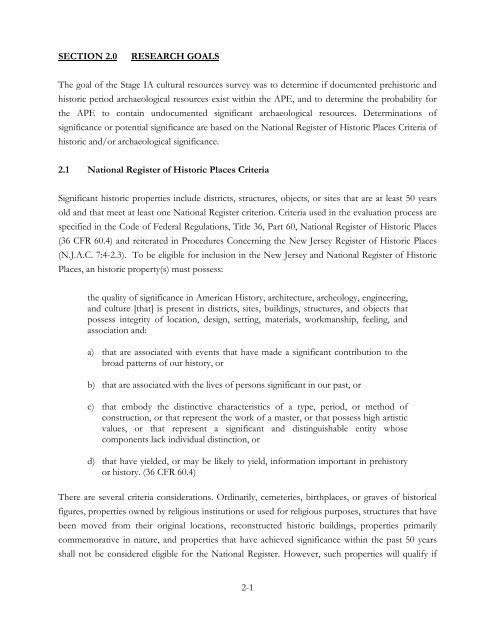APPENDIX D Cultural Resources Survey Report - US Environmental ...
APPENDIX D Cultural Resources Survey Report - US Environmental ...
APPENDIX D Cultural Resources Survey Report - US Environmental ...
You also want an ePaper? Increase the reach of your titles
YUMPU automatically turns print PDFs into web optimized ePapers that Google loves.
SECTION 2.0 RESEARCH GOALS<br />
The goal of the Stage IA cultural resources survey was to determine if documented prehistoric and<br />
historic period archaeological resources exist within the APE, and to determine the probability for<br />
the APE to contain undocumented significant archaeological resources. Determinations of<br />
significance or potential significance are based on the National Register of Historic Places Criteria of<br />
historic and/or archaeological significance.<br />
2.1 National Register of Historic Places Criteria<br />
Significant historic properties include districts, structures, objects, or sites that are at least 50 years<br />
old and that meet at least one National Register criterion. Criteria used in the evaluation process are<br />
specified in the Code of Federal Regulations, Title 36, Part 60, National Register of Historic Places<br />
(36 CFR 60.4) and reiterated in Procedures Concerning the New Jersey Register of Historic Places<br />
(N.J.A.C. 7:4-2.3). To be eligible for inclusion in the New Jersey and National Register of Historic<br />
Places, an historic property(s) must possess:<br />
the quality of significance in American History, architecture, archeology, engineering,<br />
and culture [that] is present in districts, sites, buildings, structures, and objects that<br />
possess integrity of location, design, setting, materials, workmanship, feeling, and<br />
association and:<br />
a) that are associated with events that have made a significant contribution to the<br />
broad patterns of our history, or<br />
b) that are associated with the lives of persons significant in our past, or<br />
c) that embody the distinctive characteristics of a type, period, or method of<br />
construction, or that represent the work of a master, or that possess high artistic<br />
values, or that represent a significant and distinguishable entity whose<br />
components lack individual distinction, or<br />
d) that have yielded, or may be likely to yield, information important in prehistory<br />
or history. (36 CFR 60.4)<br />
There are several criteria considerations. Ordinarily, cemeteries, birthplaces, or graves of historical<br />
figures, properties owned by religious institutions or used for religious purposes, structures that have<br />
been moved from their original locations, reconstructed historic buildings, properties primarily<br />
commemorative in nature, and properties that have achieved significance within the past 50 years<br />
shall not be considered eligible for the National Register. However, such properties will qualify if<br />
2-1

















